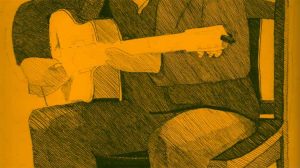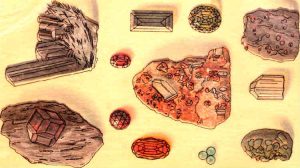The woman did not survive but the child did. Her fall was cushioned by the body of her godmother, who hit the pavement first.
He had first seen the photographs while in college, in a class called Media and Memory or something very like it. It fulfilled his second history requirement. He chose it instead of the seeming demands of The World Wars, it covered too many countries and continents; and From Revolution to Emancipation, because he felt his movie-watching habits had neatly sorted that subject. Media and Memory was a collection of still photos, videos, and films augmented by writings about how reportage impacts history. It was, of course, a requirement for journalism students. That is how he met his first college girlfriend.
Eugenie. Intensively effusive. Indelibly haunting. She was extremely serious and spoke in a staccato of sureties of how she would one day work for the New York Times or Washington Post, that she would be a dogged investigative reporter. Under her gaze and certitude he saw that he would become a war photographer. He saw himself in the future, festooned with cameras and wearing multi-pocketed vests. He saw himself with her.
When Barack Obama ran for congress, Eugenie helped Matt distribute flyers in his South Side neighborhood. They were chased off more than a couple of times. They took another class together in the spring semester, in April, when Chicago college students take their cargo shorts out of mothballs because the sun has come out and the temperature has risen slightly over 60º. They carved their names in a tree in Grant Park. Nearly. A cop saw them from far away and shouted for them to stop. They stopped carving but ran away, holding their cameras securely to their chests—hers, a Hasselblad; his, a Minolta. The portly cop didn’t give chase. The tree bore the pronouncement Eugenie ♥︎ Ma. So much time was spent on her name that Matt was truncated by the policeman. The romance failed to outlast the summer.
After college Matt became a firefighter, having declined two call-ups after passing the exam that he took on a lark. He was not allowed a third refusal and he needed a job. Photography wasn’t paying—he quit the baby photo gig at Peter Pan Studio (We Treasure Your Memories)—and waiting tables at Ann Sather (Nothing Fancy, Just Good Food) was noisy and sticky. Eugenie had gone into real estate. He saw her once, during the Sunday breakfast throng while he was serving oversized omelets, but she declined to acknowledge him. He saw her again a year later, after he had been assigned to Truck 66. It was summer and his company was out checking hydrants. If she saw him she didn’t let on.
He recalled the photograph when his house responded to a fire just north of Kenmore and Leland, only a few blocks but several incomes levels from the lakefront. The apartment building was a 4+1, four stories supported by concrete pylons between which the residents could park and scar their fenders. The early 60s buildings, that wouldn’t look out of place in Las Vegas, was seriously involved when they arrived accompanied by fire companies from both North Center and Lincoln Square— southwest and northwest of his firehouse in Uptown, and an extra ambulance from directly south by Wrigley Field. Not everyone was prepared for the challenge. O’Sullivan had been busy at the beer locker—a double wide that could accommodate a 32-gallon Rubbermaid trash barrel that was stocked each morning with Old Style and ice—and could barely hang on to the back of the engine. He was put in the jump seat and left there while the rest of the members of Truck 66 and Engine 37 moved inside and toward the top the building.
The photograph won a Pulitzer Prize. In July of 1975 there was a fire in a Victorian rowhouse on Boston’s Marlboro Street. The photographer, Stanley Forman of the Boston Herald, took several photographs of the failed rescue attempt but the prize-winning photo was of the moment of lost hope. By the time Forman arrived the Boston Fire Department had already extended an aerial ladder. A woman and her goddaughter were trapped on a top floor fire escape but a firefighter was reaching down from the ladder trying to lift them to safety. Just when rescue seemed imminent, however, the fire escape collapsed; pulling away from the brick wall, its iron fragments cascaded downward five floors, alongside potted plants and two human bodies, aged nineteen and two, over fifty feet to the ground. That was the moment of the famous photograph. Forman turned away after taking it. He didn’t want to see the impact. Diana Bryant died from her extensive injuries but the little girl, Tiare Jones, escaped death.
Matt’s fire was on the two lower floors and the men of Engine 37 had gone in at the front where the hallway was glowing yellow white. Apartments on either side of the entrance showed the same wavy illumination. Several apartments were involved and the residents, forced back by flames from the front and rear exits, had retreated to the upper floors; the building did not have an exterior fire escape. Truck 66 was an ancient heap of junk, a noisy and rusty double-clutcher equipped with a fairly limited and ratchety aerial ladder. The next fire house south housed Truck 74. Now, that was a fire truck. It was as shiny as a showroom Cadillac, like an oversized toy or a piece of candy, and had moved into the alley behind the building. Its smoothly rotating aerial ladder had risen toward the upper floors of the building, generously taking the men of Truck 66 along for the ride. The moment he reached the top of the ladder Matt recalled the famous photo. Extended toward a fourth-floor window the ladder placed Matt within the reach of a distraught mother, who pleadingly handed her child to him. The girl had tears streaming down her cheeks but when the mother trustingly transferred her daughter to Matt the child let out a piercing scream and pushed her hands to his chest. She fought to stay with her mother—clasping, screaming—and Matt had to grasp her firmly to keep her from wriggling away, more firmly than he thought he should grab a child but it was nearly fifty feet to the ground; climbing backward he had to hold on to her. Four stories below was the sloping asphalt apron leading to the building’s parking lot. Matt could not expel the Marlboro Street photo from his head. Don’t drop the baby. Don’t drop the baby. Don’t drop the baby. He repeated that in his head. Don’t drop the baby.
Matt held on tight to the screaming child, her cries a high-pitched wailing fear of this stranger in the black helmet and coat, striped with wide bands of reflective yellow. The child grabbed each rung of the ladder as they moved downward. She could see the chaos below, of trucks and flashing lights, and onlookers. People in the apartment buildings across the alley were on their back porches viewing the spectacle as if from opera boxes. He didn’t look down except quick glimpses of the beams of the ladder, with every step keeping the outside of his boots in contact with the inside of the beams. He could see the scramble of adults pouring out of the open window and his colleague above helping them swiftly but carefully onto the ladder. He felt the weight of each new passenger. But, so did the child. She was surprisingly, disconcertingly strong, holding on to the ladder in terror of falling, of losing her mother. Matt in turn squeezed her tighter, intensifying her screams, wondering how a four-year-old could have so much strength. She grabbed his face and screamed into it, he responded by holding her still more firmly to his chest, stifling her cries and relieving himself of her fears and his own. When he reached the bottom, and finally felt his feet on the turntable, the girl was whisked from his arms and handed down to another firefighter who, in turn, handed her off to… a stranger. Matt watched the girl being passed along a chain of neighbors until she reached an older woman, a grandmother perhaps, who smothered the girl in a desperate embrace.
The mother was on the 10 O’Clock News and mentioned that wonderful fireman who saved her baby. The report also included a short video clip of Matt descending the ladder backward. It was only three seconds long and his face wasn’t visible, and the little girl was almost completely obscured. But always eager for positive public relations—particularly after the Fire Commissioner was discovered to have lied on his CV and forced to resign—the Director for Media Affairs arranged for a photo op at the firehouse, with Matt and the mother, Angela Mays, and her daughter, April. April didn’t scream at Matt. She did not push him away. She did not hit him. Matt held her in his arms. She smiled at him and everyone smiled for the camera. Three smiling Black people against a background of smiling White firefighters. The department sent out a press release. After learning that Matt actually had a college degree, unlike the former Fire Commissioner, the Director of Media Affairs suggested a transfer to his office, which had an education unit downtown at the Fire Academy. It would not offer the lush firehouse hours—24 hours on/48 hours off—but it would not require any predawn outdoor work in an icy Chicago January. Also, civilian clothes. The transfer was speedily approved.
After seeing Matt’s picture in the paper Eugenie phoned. He was delighted to hear from her, despite his residual anger. She invited him out for dinner. They smiled and talked about old times, and at the end of the night she tried to sell him a condo.




Drager Meurtant says
Curious to know what the condo was like…?
No, gripping story, by an author who knows hoe to place and serve the elements that matter.